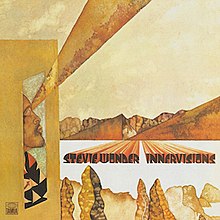| Innervisions | ||||
|---|---|---|---|---|
 | ||||
| Studio album by | ||||
| Released | August 3, 1973 | |||
| Recorded | 1973[citation needed] | |||
| Studio |
| |||
| Genre | ||||
| Length | 43:52 | |||
| Label | Tamla | |||
| Producer |
| |||
| Stevie Wonder chronology | ||||
| ||||
| Singles from Innervisions | ||||
| ||||
Innervisions is the sixteenth studio album by American singer, songwriter, and musician Stevie Wonder, released on August 3, 1973, by Tamla, a subsidiary of Motown Records. A landmark recording of Wonder's "classic period",[3] the album has been regarded as completing his transition from the "Little Stevie Wonder" known for romantic ballads into a more musically mature, conscious, and grown-up artist. On the album, Wonder continued to experiment with the revolutionary T.O.N.T.O. (The Original New Timbral Orchestra) synthesizer system developed by Malcolm Cecil and Robert Margouleff, and Innervisions became hugely influential on the future sound of commercial soul and black music.
The album peaked at number four on the Billboard Top LPs & Tapes chart and number one on the Billboard Soul LPs chart, eventually finishing at number four on the magazine's Top Pop Albums chart for 1974. At the 16th Grammy Awards, it won Album of the Year and Best Engineered Non-Classical Recording, while "Living for the City" won Best R&B Song. Innervisions is widely considered by fans, critics, and colleagues to be one of Wonder's finest works and one of the greatest albums of all time. It was ranked number 34 on Rolling Stone's list of "The 500 Greatest Albums of All Time" in 2020 and was inducted into the Grammy Hall of Fame in 1999.[4]
- ^ Martin, Bill (1998), Listening to the Future: The Time of Progressive Rock, Chicago: Open Court, p. 41, ISBN 0-8126-9368-X
- ^ Perone, James E. (2012). The Album: A Guide to Pop Music's Most Provocative, Influential, and Important Creations, Volume 1. ABC-CLIO. p. x. ISBN 978-0313379062.
Wonder integrated soul, funk, rock, torch song, and jazz on his 1972 album Talking Book and his 1973 album Innervisions.
- ^ Some observers count six classic albums, some count five, and others count four.
Bogdanov, Vladimir; Woodstra, Chris; Erlewine, Stephen Thomas (2001). All Music Guide: The Definitive Guide to Popular Music (4 ed.). Hal Leonard Corporation. pp. 447–448. ISBN 0-87930-627-0.
Cramer, Alfred William (2009). Musicians and Composers of the 20th Century. Vol. 5. Salem Press. p. 1645. ISBN 978-1-58765-517-3.
Brown, Jeremy K. (2010). Stevie Wonder: Musician. Black Americans of Achievement. Infobase Publishing. p. 57. ISBN 978-1-60413-685-2. - ^ "GRAMMY Hall Of Fame". GRAMMY.com. October 18, 2010. Retrieved December 30, 2019.